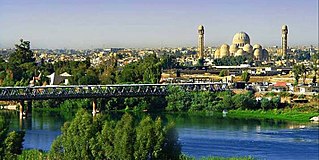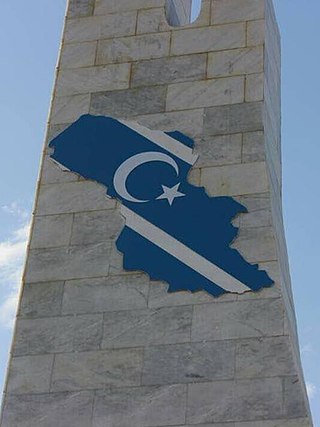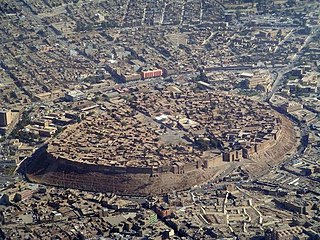
Mosul is a major city in northern Iraq, serving as the capital of Nineveh Governorate. The city is considered the second-largest city in Iraq in terms of population and area after the capital Baghdad. Mosul is approximately 400 km (250 mi) north of Baghdad on the Tigris river. The Mosul metropolitan area has grown from the old city on the western side to encompass substantial areas on both the "Left Bank" and the "Right Bank", as locals call the two riverbanks. Mosul encloses the ruins of the ancient Assyrian city of Nineveh – once the largest city in the world – on its east side.

Nineveh or Ninawa Governorate is a governorate in northern Iraq. It has an area of 37,323 km2 (14,410 sq mi) and an estimated population of 2,453,000 people as of 2003. Its largest city and provincial capital is Mosul, which lies across the Tigris river from the ruins of ancient Nineveh. Before 1976, it was called Mosul Province and included the present-day Dohuk Governorate. The second largest city is Tal Afar, which has an almost exclusively Turkmen population.

The Iraqi Turkmen Front is a political movement representing the Iraqi Turkmen people. It was founded on April 5, 1995 as a coalition of several Turkmen parties operating within the framework of Iraq's unity. The party aims for the Turkmen community to have greater political involvement, increased recognition and more rights.

The Great Zab or Upper Zab is an approximately 400-kilometre (250 mi) long river flowing through Turkey and Iraq. It rises in Turkey near Lake Van and joins the Tigris in Iraq south of Mosul. During its course, the river collects water from many tributaries and the drainage basin of the Great Zab covers approximately 40,300 square kilometres (15,600 sq mi). The river and its tributaries are primarily fed by rainfall and snowmelt – as a result of which discharge fluctuates highly throughout the year. At least six dams have been planned on the Great Zab and its tributaries, but construction of only one, the Bekhme Dam, has commenced but was halted after the Gulf War.

Qaraqosh, is an Assyrian city in the Nineveh Governorate, of Iraq located about 32 kilometres (20 mi) southeast of the city of Mosul and 60 kilometres (37 mi) west of Erbil amid agricultural lands, close to the ruins of the ancient Assyrian cities Kalhu and Nineveh.

The 2004 Erbil bombings was a double suicide attack on the offices of Iraqi Kurdish political parties in Erbil, Kurdistan Region on 1 February 2004. The attackers detonated explosives strapped to their bodies as hundreds gathered to celebrate Eid Al-Adha in Erbil.

Turkmeneli, also known as Turkmenland, and historically as Turcomania,, and East Turkmeneli is a political term used to define the vast swath of territory in which the Iraqi Turkmens historically have had a dominant population. The term incorporates the Iraqi Turkmen homelands running from Iraq's border with Turkey and Syria and diagonally down the country to the border with Iran. It is sometimes referred to as East Turkmeneli to distinguish from the Syrian Turkmen homeland, known as West Turkmeneli. Apart from the designation of the region as Turcomania in a 1785 map by William Guthrie, there's no certain mention of the region in published works until the establishment of the Iraqi Turkmen Front.
The 2009–10 Iraqi Premier League was the 36th edition of the competition. It was initially set to start in October 2009, but was later rescheduled for December as a 36-team league. The season saw Duhok crowned as champions for the first time.

Metropolitanate of Adiabene was an East Syriac metropolitan province of the Church of the East between the 5th and 14th centuries, with more than fifteen known suffragan dioceses at different periods in its history. Although the name Hadyab normally connoted the region around Erbil and Mosul in present-day Iraq, the boundaries of the East Syriac metropolitan province went well beyond the Erbil and Mosul districts. Its known suffragan dioceses included Beth Bgash and Adarbaigan, well to the east of Adiabene proper.

Erbil, also called Hawler, is the capital and most populated city in the Kurdistan Region of Iraq. The city is in the Erbil Governorate.
Infrastructure of Iraq describes the infrastructure of the country of Iraq. Throughout the history of Iraq, the country's infrastructure, along with its politics and economy, have been affected by armed conflicts; none more serious than the 2003 Invasion and subsequent reconstruction.
Between 1 and 15 August 2014, the Islamic State of Iraq and the Levant (ISIL) expanded territory in northern Iraq under their control. In the region north and west from Mosul, the Islamic State conquered Zumar, Sinjar, Wana, Mosul Dam, Qaraqosh, Tel Keppe, Batnaya and Kocho, and in the region south and east of Mosul the towns Bakhdida, Karamlish, Bartella and Makhmour

The Chaldean Catholic Archdiocese of Erbil is a Chaldean Catholic diocese with its seat in Erbil, Kurdistan Region. Erected in 1968 with territory taken from the Archeparchy of Kirkuk, it is immediately subject to the Patriarchal See of Babylon. The see of the archbishop is the Cathedral of St. Joseph in Ankawa, a suburb of Erbil.

The Khazir River is a river of northern Iraq, a tributary of the Great Zab river, joining its right bank.
The Nineveh Plains offensive was a battle in which the Islamic State of Iraq and the Levant (ISIL) mounted a multi-front attack against Peshmerga forces in the area north and east of Mosul, in December 2015. The attack—the most significant ISIL military operation in the area in months, was successfully repelled by the Kurdish forces and was followed by a coalition air counter-offensive.

The Shirqat offensive, codenamed Operation Conquest or Operation Fatah, was an offensive against the positions of the Islamic State of Iraq and the Levant (ISIL) in and around the district of Al-Shirqat District to reach the city of Mosul.

The Battle of Mosul was a major battle initiated by the Iraqi Government forces with allied militias, the Kurdistan Regional Government, and international forces to retake the city of Mosul from the Islamic State (ISIL), which had seized the city years prior in June 2014. It was the largest conventional land battle since the capture of Baghdad in 2003. It was also the world's single largest military operation overall since the 2003 invasion of Iraq and was considered the toughest urban battle since World War II. The operation, which was called Operation "We Are Coming, Nineveh", began on 16 October 2016, with forces besieging ISIL-controlled areas in the Nineveh Governorate surrounding Mosul, and continued with Iraqi troops and Peshmerga fighters engaging ISIL on three fronts outside Mosul, going from village to village in the surrounding area in the largest deployment of Iraqi troops since the 2003 invasion of Iraq.

The Catholic University in Erbil (CUE) ܒܹܝܬܼ ܨܵܘܒܵܐ ܩܵܬܼܘܿܠܝܼܩܵܝܵܐ ܒܐܲܪܒܝܠ
is a private non-profit institution of higher education and research located in the Erbil suburb of Ankawa, Kurdistan Region, Iraq
The Battle of Khazir took place in August 686 near the Khazir River in Mosul's eastern environs, in modern-day Iraq. The battle occurred during the Second Muslim Civil War and was part of the larger struggle for control of Iraq between the Syria-based Umayyad Caliphate, the Kufa-based pro-Alid forces of Mukhtar al-Thaqafi, and the Mecca-based caliphate of Abd Allah ibn al-Zubayr. It ended in a rout for the Umayyads and the expansion of Mukhtar's rule into the region of Mosul.














